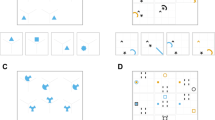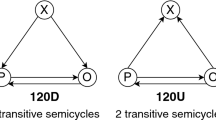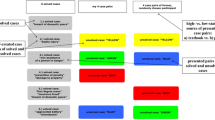Abstract
Using Bayesian inference, this study aims to estimate the magnitude of the cognitive load when a person perceives asymmetric social relations. Some empirical evidence relating to balance theory has shown that a balanced state is comparatively easier to memorize than an unbalanced one. In this study, since a balanced state is defined by structural complexity, an experimental hypothesis was set whereby asymmetric social relationships have different difficulty levels depending on structural complexity. The balanced state of an asymmetric relation as structural difficulty is formally derived from the eigenvalue structure of a Hermitian matrix. Asymmetric triadic relations are modeled as featuring three kinds of structural difficulties according to the eigenvalue decomposition of the Hermitian matrix and pattern-specific difficulties. The differences among the structural difficulties were not sufficiently significant to exceed pattern-specific difficulties, but the Bayes factor of the informational hypothesis of this research yielded positive effects.



Similar content being viewed by others
Notes
For individual differences \(\theta \), and a vaguelle uniform distribution such as \({\text {Uniform}}(-100,100)\), this model will not converge. However, it is a natural assumption to use a normal distribution for individual difference, rather than a standard normal distribution. Even if a standard normal distribution is assumed, numerical values such as the Bayes factor described below would change, but research hypothesis shown in this paper remains unchanged and consistent results are obtained.
The complexity of the hypothesis is, for example, in the case of this study, \(H_1\) places two inequality constraints out of the three parameters, and since the combination is \(3! = 6\), one of them complicates \(c_1 = 1/6 \). Similarly, it is 1/3 of the complexity for the hypothesis \(H_2, H_3\) (Okada 2014).
The details are provided by Kruschke (2014).
See the following URL: https://osf.io/fnnk4/
References
Abelson R, Rosenberg M (1958) Symbolic psycho-logic: a model of attitudinal cognition. Behav Sci 3:1–13
Cartwright D, Harary F (1956) Structural balance: a generalization of Heider’s theory. Psychol Rev 63:277–293
Chino N (1997) Asymmetric multi-dimensional scaling. Genda Sugaku Sha, Kyoto
Chino N (2011) Asymmetric multidimensional scaling. J Inst Psychol Phys Sci 3(1):101–107
Davis J (1967) Clustering and structural balance in graphs. Hum Relat 20:181–187
Davis JA, Leinhardt S (1967) The structure of positive interpersonal relations in small groups. In: Berger J, Zelditch M Jr (eds) Sociological theories in progress, vol 2. Mifflin Company, Boston, pp 218–251
Doreian P, Krackhardt D (2001) Pre-transitive balance mechanisms for signed networks. J Math Sociol 25(1):43–67
Festinger L (1962) A theory of cognitive dissonance, vol 2. Stanford University Press, Palo Alto
Gelman A et al (2006) Prior distributions for variance parameters in hierarchical models (comment on article by browne and draper). Bayesian Anal 1(3):515–534
Heider F (1958) The psychology of interpersonal relations. Wiley, New York
Hunter J (1978) Dynamic sociomtery. J Math Sociol 6:87–138
Jordan N (1953) Behavioral forces that are a function of attitudes and of cognitive organization. Hum Relat 6:273–287
Kass RE, Raftery AE (1995) Bayes factors. J Am Stat Assoc 90(430):773–795
Katz L (1947) On the matric analysis of sociometric data. Sociometry 10:233–241
Klugkist I, Laudy O, Hoijtink H (2005) Inequality constrained analysis of variance: a Bayesian approach. Psychol Methods 10(4):477
Kosugi K, Fujisawa T, Fujihara T (2004) Isomorphism of balance theory and Eigen-decomposition. Sociol Theory Methods 19(1):87–100
Kruschke J (2014) Doing Bayesian data analysis: a tutorial with R, JAGS, and Stan. Academic Press, Cambridge
Lee MD, Wagenmakers EJ (2014) Bayesian cognitive modeling: a practical course. Cambridge University Press, Cambridge
MacRae D Jr (1960) Direct factor analysis of sociometric data. Sociometry 23:360–371
Morrissette J (1958) An experimental study of the theory of structural balance. Hum Relat 11:239–254
Newcomb T (1953) An approach to the study of communicative acts. Psychol Rev 60(6):393–404
Nishisato S (1994) Elements of dual scaling: an introduction to practical data analysis. Lawrence Erlbaum, Hillsdale
Noma E, Smith D (1985a) Benchmark for the blocking of sociometric data. Psychol Bull 97(3):583–591
Noma E, Smith D (1985b) Scaling sociometrics by optimizing an explicit function: correspondence analysis of binary single response soiciomatrices. Multivar Behav Res 20:179–197
Okada A, Imaizumi T (1997) Asymmetric multidimensional scaling of two-mode three-way proximities. J Classif 14(2):195–224
Okada K (2014) Does Bayesian evaluation of informative hypothesis outperform analysis of variance? Jpn J Psychon Sci 32(2):223–231
Osgood C, Tannenbaum P (1955) The principle of congruity in the prediction of attitude change. Psychol Rev 62(1):42–55
Phillips J (1967) A model for cognitive balance. Psychol Rev 74:481–495
Plummer M, Best N, Cowles K, Vines K (2006) CODA: convergence diagnosis and output analysis for MCMC. R News 6(1):7–11. https://journal.r-project.org/archive/
R Core Team (2016) R: a language and environment for statistical computing. R Foundation for Statistical Computing, Vienna, Austria. https://www.R-project.org/
Rubin Z, Zajonc B (1969) Structural bias and generalization in the learning of social structures. J Personal 37:310–324
Stan Development Team (2016) RStan: the R interface to Stan. http://mc-stan.org/ (R package version 2.14.1)
Taylor H (1970) Balance in small groups. Litton Educational Publishing, New York
Wasserman S, Faust K, Galaskiewicz J (1990) Correspondence and canonical analysis of relational data. J Math Sociol 15(1):11–64
Watts DJ (1999) Small worlds: the dynamics of networks between order and randomness. Princeton University Press, Princeton
Zajonc R, Burnstein E (1965a) The learning of balance and unbalanced social structures. J Personal 33:153–163
Zajonc R, Burnstein E (1965b) Structural balance, reciprocity, and positivity as sources of cognitive bias. J Personal 33:570–583
Zajonc R, Sherman S (1967) Structural balance and the induction of relations. J Personal 35:635–650
Acknowledgements
This work was supported by JSPS KAKENHI Grant number 16K13459 and special Thanks to Dr. Hiroshi Shimizu (Kwansei Gakuin Univ.) and Dr. Hirakawa Makoto (Hiroshima Univ.).
Author information
Authors and Affiliations
Corresponding author
Additional information
Communicated by: Kensuke Okada.
About this article
Cite this article
Kosugi, K.E. Asymmetrical triadic relationship based on the structural difficulty. Behaviormetrika 45, 7–23 (2018). https://doi.org/10.1007/s41237-017-0033-9
Received:
Accepted:
Published:
Issue Date:
DOI: https://doi.org/10.1007/s41237-017-0033-9




